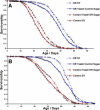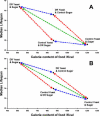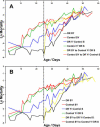Calories do not explain extension of life span by dietary restriction in Drosophila
- PMID: 16000018
- PMCID: PMC1140680
- DOI: 10.1371/journal.pbio.0030223
Calories do not explain extension of life span by dietary restriction in Drosophila
Abstract
Dietary restriction (DR) extends life span in diverse organisms, including mammals, and common mechanisms may be at work. DR is often known as calorie restriction, because it has been suggested that reduction of calories, rather than of particular nutrients in the diet, mediates extension of life span in rodents. We here demonstrate that extension of life span by DR in Drosophila is not attributable to the reduction in calorie intake. Reduction of either dietary yeast or sugar can reduce mortality and extend life span, but by an amount that is unrelated to the calorie content of the food, and with yeast having a much greater effect per calorie than does sugar. Calorie intake is therefore not the key factor in the reduction of mortality rate by DR in this species.
Conflict of interest statement
Competing interests. The authors have declared that no competing interests exist.
Figures





Similar articles
-
Counting calories in Drosophila diet restriction.Exp Gerontol. 2007 Mar;42(3):247-51. doi: 10.1016/j.exger.2006.10.009. Epub 2006 Nov 27. Exp Gerontol. 2007. PMID: 17125951 Free PMC article.
-
Counting the calories: the role of specific nutrients in extension of life span by food restriction.J Gerontol A Biol Sci Med Sci. 2005 May;60(5):549-55. doi: 10.1093/gerona/60.5.549. J Gerontol A Biol Sci Med Sci. 2005. PMID: 15972601 Review.
-
Sir2 mediates longevity in the fly through a pathway related to calorie restriction.Proc Natl Acad Sci U S A. 2004 Nov 9;101(45):15998-6003. doi: 10.1073/pnas.0404184101. Epub 2004 Nov 1. Proc Natl Acad Sci U S A. 2004. PMID: 15520384 Free PMC article.
-
Protein:carbohydrate ratios explain life span patterns found in Queensland fruit fly on diets varying in yeast:sugar ratios.Age (Dordr). 2012 Dec;34(6):1361-8. doi: 10.1007/s11357-011-9308-3. Epub 2011 Sep 9. Age (Dordr). 2012. PMID: 21904823 Free PMC article.
-
Dietary restriction in Drosophila: delayed aging or experimental artefact?PLoS Genet. 2007 Apr 27;3(4):e57. doi: 10.1371/journal.pgen.0030057. PLoS Genet. 2007. PMID: 17465680 Free PMC article. Review.
Cited by
-
Dietary protein and lifespan across the metamorphic boundary: protein-restricted larvae develop into short-lived adults.Sci Rep. 2015 Jun 29;5:11783. doi: 10.1038/srep11783. Sci Rep. 2015. PMID: 26119686 Free PMC article.
-
Intramyocellular fatty-acid metabolism plays a critical role in mediating responses to dietary restriction in Drosophila melanogaster.Cell Metab. 2012 Jul 3;16(1):97-103. doi: 10.1016/j.cmet.2012.06.005. Cell Metab. 2012. PMID: 22768842 Free PMC article.
-
Secrets of the lac operon. Glucose hysteresis as a mechanism in dietary restriction, aging and disease.Interdiscip Top Gerontol. 2007;35:39-68. doi: 10.1159/000096555. Interdiscip Top Gerontol. 2007. PMID: 17063032 Free PMC article. Review.
-
Distinct genomic signals of lifespan and life history evolution in response to postponed reproduction and larval diet in Drosophila.Evol Lett. 2019 Oct 2;3(6):598-609. doi: 10.1002/evl3.143. eCollection 2019 Dec. Evol Lett. 2019. PMID: 31867121 Free PMC article.
-
The DHR96 nuclear receptor controls triacylglycerol homeostasis in Drosophila.Cell Metab. 2009 Dec;10(6):481-90. doi: 10.1016/j.cmet.2009.10.010. Cell Metab. 2009. PMID: 19945405 Free PMC article.
References
-
- Masoro EJ. Amsterdam: Elsevier; 2002. Caloric restriction: A key to understanding and modulating aging; 183 pp.
-
- Weindruch R, Walford RL. Springfield (Illinois): Thomas; 1988. The retardation of aging and disease by dietary restriction; 436 pp.
-
- McCay CM, Crowell MF, Maynard LA. The effect of retarded growth upon the length of life span and upon the ultimate body size. J Nutr. 1935;10:63–79. - PubMed
-
- Jiang JC, Jaruga E, Repnevskaya MV, Jazwinski SM. An intervention resembling caloric restriction prolongs life span and retards aging in yeast. FASEB J. 2000;14:2135–2137. - PubMed
Publication types
MeSH terms
Substances
Grants and funding
LinkOut - more resources
Full Text Sources
Other Literature Sources
Molecular Biology Databases

